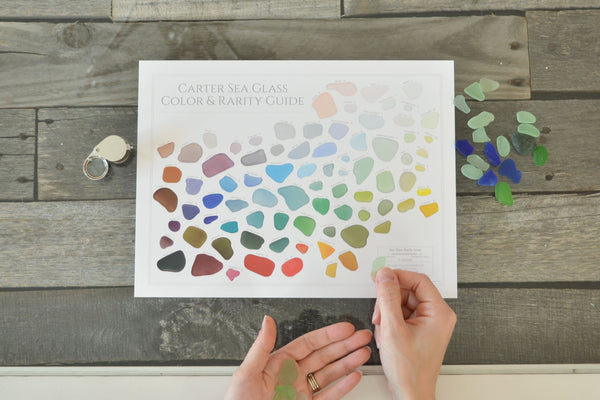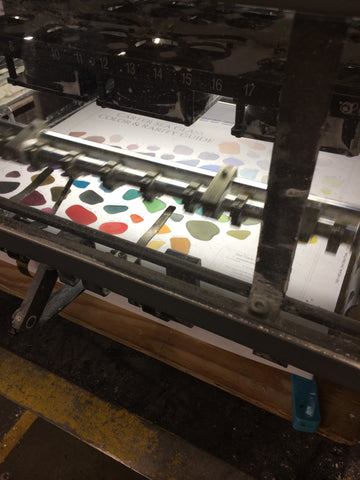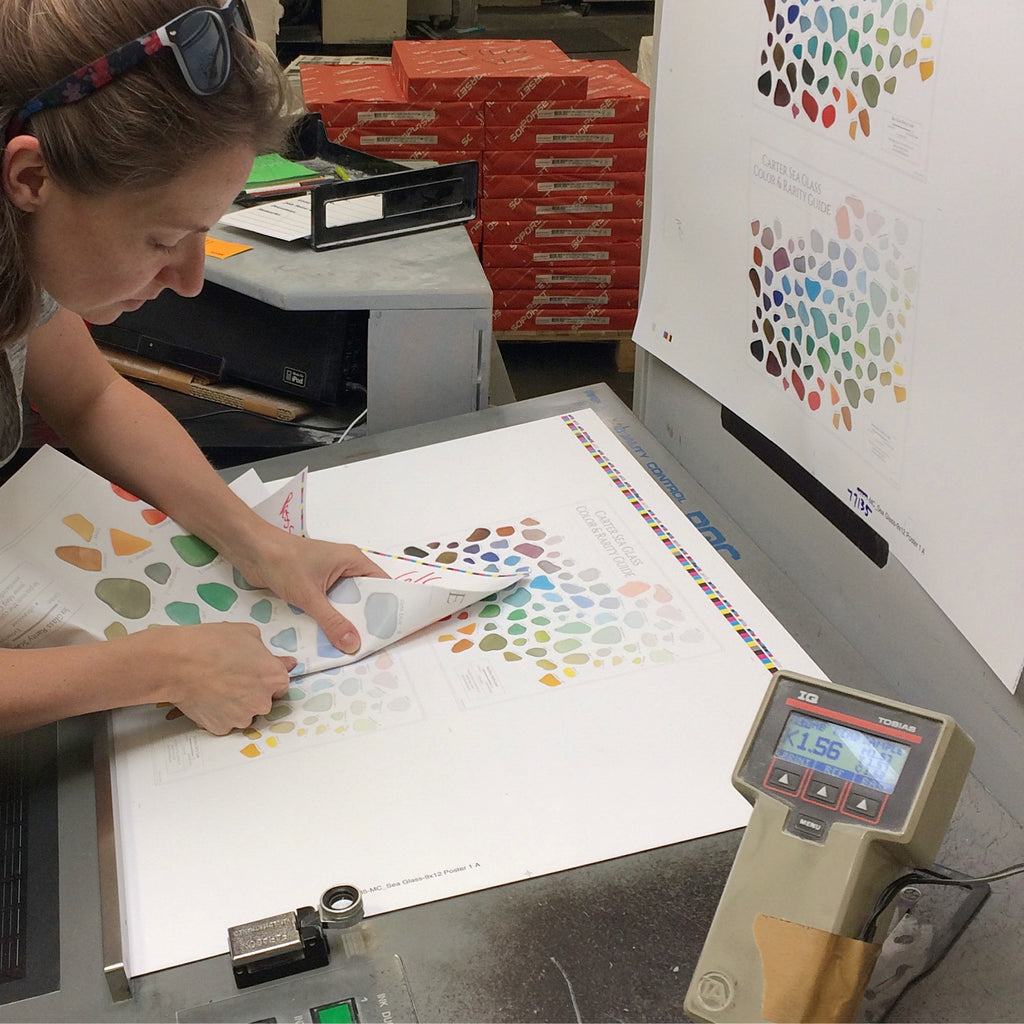Carter Sea Glass Color and Rarity Guide

By Meg Carter
It’s much more than a color and rarity guide. Here is the story of how it all came to be and after three years what it has become.
What’s in a name? Well... everything! After years of collecting and being a professional sea glass jeweler, I found the sea glass community was in a discrepancy about what to call colors. Even in my own home, my husband, Jon, and I would debate about what the name of a color should be. I would call it aqua and he would call it turquoise. Then I would hold up a piece of glass that I would call turquoise and ask him, “Then what would you call this color?” and I would get a puzzled look from him, kind of saying, “Well, I guess you have a point.”
For years now, I have run into an issue with colors when it comes to custom orders. I specialize in sea glass engagement rings. Nine out of ten customers request a greenish blue/aqua color. Not knowing exactly what color they mean, I will always send a picture of various shades of green, blue and aqua glass to have them select which color they had in mind. After they select a piece, I often find they really meant a shade of blue that I would consider turquoise.
In thinking about this in other terms, suppose you were having your living room painted. Obviously, the painters would ask what color you would like. If you responded with blue, the actual shade of blue you end up with could be a completely different blue than you had in mind because of interpretation. That is why paint colors have names and numbers associated with them to specify what blue you would like. I was in desperate need of this kind of system for sea glass.
Throughout the online sea glass community, I saw a difference in color names. Collectors, jewelers and artists were using all different names for similar colors. While others didn’t know what to call some colors and were reaching out for a suggestion, they would post a piece and ask, “What would you call this color? I have never seen it before.” So I decided to test a theory of just how different answers might be to the question, “What color is this?” I posted a picture of five pieces of blue shades of sea glass on Instagram and Facebook asking, “What would you call these colors from left to right?” After fifty comments with fifty different answers, it was very evident that color names were completely all over the board. When my experiment was complete, I posted my names for the five pieces. I was surprised when a fellow sea glass jeweler, Sunny Laursen, commented, “I like your color names! And I will use them myself now! Color names unite.”

As I was awake, my idea blossomed. My plan was to make the guide a poster. Although I have found my place in making jewelry, my background is actually in painting and 2D arts. I have a degree in art and wanted to put it to good use. Not only did I want this to be a useful tool, but also a piece of art that my college professor would be proud of (which I was right about; she has a copy in her office).
For years I have beachcombed myself and purchased sea glass from collectors all over the world. To get started, I went to my sea glass collection to select one piece of each color. With my first selection of colors I had over one hundred shades. I went through each color comparing and eliminating shades that were too close to one another. Narrowing them down proved to be a difficult task because there seemed to be infinite shades of each color, particularly green. I wanted users of the guide to be able to distinguish, without a doubt, one color from another. None of them could be too close to each other. Now having a good grasp on a rough draft of pieces it was time to name them. I called on Jon to assist with this part.

The reason it was difficult is because I set guidelines for naming. First, I wanted each name to be a universally known descriptive color. For example, instead of naming a color something that is open to interpretation, like Harbor Town, I used the name, Steel Blue. I wanted a collector to be able to imagine the color without seeing the guide itself. Another rule I wanted to follow was not to use words like dark, light, pale, electric or deep. I wanted to avoid these words because I wanted the names to be consistent, and using tone-descriptive words for some color families and not others would be inconsistent. Once all the pieces were named it was time to add the rarity scale.
I thought including the rarity in the guide in addition to the names would make it more interesting and useful. I wanted the scale to be easy to understand and interpret. Being a jeweler, I am very familiar with the Mohs scale of hardness. This scale uses a 1-10 scale to rate the hardness of minerals. I thought the idea of a 1-10 scale to rate rarity would be easy for collectors of all ages to understand. With this step complete, all the names and rarity were set. It was time to create the guide.
The first step in creating the actual guide was to photograph all the pieces. I photographed each of the pieces five times to achieve the look I wanted. I took the pictures of the pieces outside in direct sunlight. I flooded the pieces with light by surrounding them with white. I also raised the pieces off the surface of the area by putting them on a piece of clear glass to let the light shine through from all angles. Next was the photo editing process.
Although the guide gives the effect of all the pieces being one image, I actually created the cohesive look with each individual piece. After creating a separate image for each piece I was able to move them around and arrange them in whatever pattern I wanted. I arranged all of the pieces six different ways before ultimately selecting the fade from light to dark. I selected this layout so users would be able to hold up a piece of glass to compare and have pieces of the same color family be in the same area. Before coming up with a final design, I needed to make sure the color was exactly what the actual piece of glass was. Perfecting each piece when it came to the color was an extremely tedious and lengthy process.

Sheriar wanted me to be there when they were printing to make sure everything was spot-on, and it was. We made sure with the exact pieces of glass against the print. I have also been there to do this with each reprint through the years. I was so excited to see the production in process. After so many hours of work it was a dream come true to see it in the hundreds printed. I didn’t sleep that night. I was so excited to share what I had created with the sea glass community.
Here we are three years later and the guide has become so much more than I ever imagined on the day it launched. I am honored knowing most of you reading this are likely an owner of a copy.
Thousands have been purchased by jewelers, artists and collectors all over the world. From Israel to Kentucky and Tasmania to Iceland, I am so grateful to think my art is hanging up literally all over the world. It is the kind of stuff artists dream about and I thank you from the bottom of my heart. It is not the locations and numbers that blow my mind though - it is the stories that bring tears to my eyes.
One story was of a mother and son finding common interest over collecting and sorting using the guide. They went so far as to get eighty-one jars, one for each color on the guide.
Countless times I have heard stories of grandchildren bonding with their grandparents over a kitchen table with the guide laid out beside the day’s haul from the beach. “I got a cucumber!” or “I found a sky!” These are the kinds of memories the kids will have of their grandparents for years and years.
A husband and wife would go to the beach. The wife would walk the beach looking for glass while her husband would stay in the car reading the paper. After hanging the guide in the hallway of their home, he started getting out of the car. Finding a new color or more rare color was now a challenge.
And as my original intention of having engagement ring customers tell me what color they would like for their ring, it happens often.
The guide is available in poster size and travel size with the option of lamination for sorting right on the guide. It can be purchased on madebymeg.net.
Watch videos about all the colors of sea and beach glass
Learn more about sea and beach glass colors:
This article appeared in the Glassing Magazine September/October 2018 issue.
3 comments
I love the guide. My daughter bought me the poster for Christmas ! I will be purchasing the travel guide so that I don’t have to wait to get home from my Seaglass hunt, to match my colors ❤💙💚💜
Meg, I love your passion! You are so talented !!
Where do I purchase this chart.
How do I get this chart???








